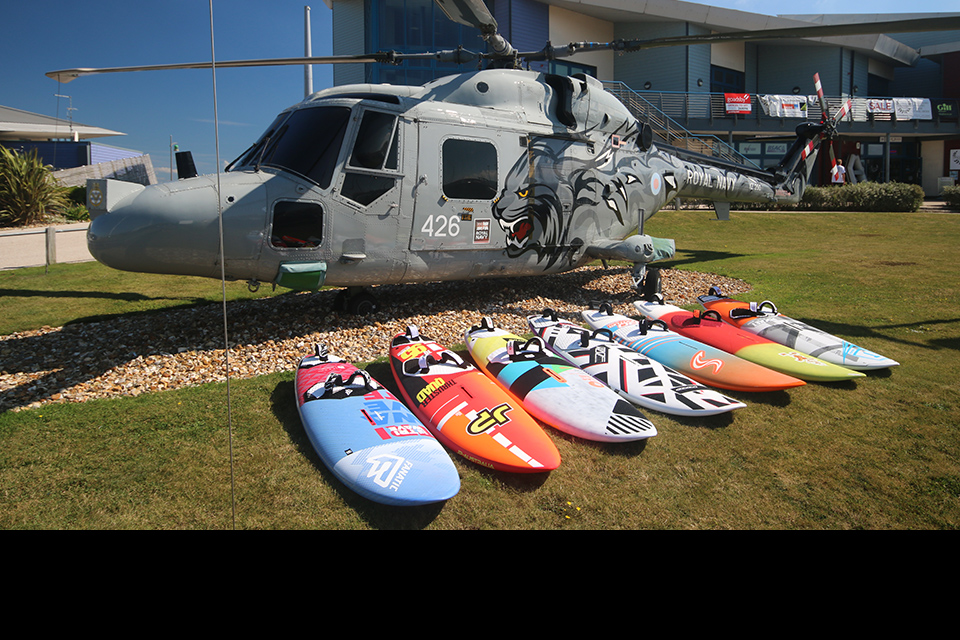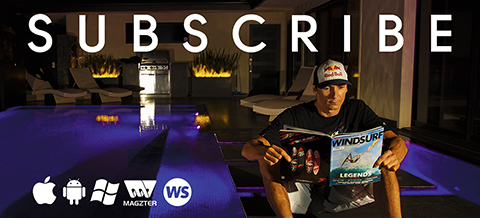HIGH FLYERS
90L WAVE BOARD TEST 2017
Test Editor Tris Best // Second Testers Maurin Rottenwalter, Joe North, Nick Moffatt & Tom Squires
Photos Alex Best // Test Location Gwithian, Rhosneigr and Overcombe
The large wave board has become an infinitely more diverse and versatile beast in the recent past. Multi-fin options have helped to transform the category from the sole domain of the heavier rider, to almost the go-to-board for the average weight sailor encountering fickle variable winds that we are all too often accustomed to around Britain’s shores. And yet, there have been downsides to the fin development path as well… With each brand offering a quad and thruster option in their range at the very least, it has to be a given that it created yet more confusion in the market. If not confusion, then it’s only human nature to question your decision in the board you chose… particularly if you’re not getting on with it!
This test was originally published in the October 2016 issue.
FINDINGS
Multi-fin boards have been tried and re-tried on the production market ever since ‘funboarding’ exploded onto the windsurfing scene. The Mistral Ho’okipa of the eighties; the BiC Saxo in the mid-nineties … all showed promise and yet were flawed by one simple fact: production board weights were simply not comparable to custom board weights … and adding more than one finbox into the tail of the board only exacerbated this fact further. Today, board production has been ‘standardised’ somewhat, with the vast majority of brands using the Cobra factory in Thailand as their fabricator. The void between ‘custom’ and ‘production’ has been blurred and the technologies used to manufacture the boards are constantly being evolved to reduce weight without compromising strength and performance, including factors such as flex. ‘Smart’ carbon … ‘Light Finish Technology’, call it what they will, all brands are looking to choose and use their layering materials sparingly yet wisely, to reduce weight and ensure the production board’s performance resembles that of the chosen prototype. And a lot of work has been done at reducing finbox weight as well, enabling their inclusion in numbers, without undoing the hard work done elsewhere with the board. The new Starbox from Starboard is the latest addition, combining a US style track with the screw-fixing method of the slotbox. It will have fin manufacturers up in arms, blustering that it is at least the sixth fin-head style they will now need to cater for (with US, Power, Tuttle, mini-Tuttle, Slot all still in use), and yet having used the Starbox on both the Ultra Kode here and the Reactor last month, we can certainly see the merits. It makes fin changing easy and precise to facilitate, which above all else, makes the rider more likely to do it as a result. Sorry fin brands … but that can only be a good thing.
So what fin setup to choose – thruster or quad? Much like the number of rotors on a helicopter, the number of ‘foils’ or ‘blades’ used has both advantages and disadvantages. As a very rough guide, here is the generally accepted rule:
• Quad: Best overall in side-offshore, down the line wave riding.
• Thruster: More manoeuvrable version of the single fin, with better control. Best for cross-onshore to cross-shore conditions.
• Twinser: Livelier option of the quad setup.
• Single: Early planing, directional feel with best drive.
There are of course exceptions to this rule, with the designers of different brands having their own interpretation. Fin setup is of course just one design parameter, coexisting and working directly with the board’s other specifications, such as tail design, width and volume distribution. However, the beauty with the direction in the market today is that most boards can be setup up in all the above fin configurations. So gone are the days that you needed to choose between thruster or quad it seems! The option you’re now faced with, looking at the ranges of most brands, is whether you go ‘real world’ wave board, the mainstream go-anywhere option (the Thruster Quad in JP’s range, for example) … or the dedicated wave tool that is more niche in the conditions it craves (eg the JP Radical Thruster Quad). The market has evolved so that the decision at the buying phase is less of an ordeal. The decision can now be made on the beach when tuning your board for the conditions you’re about to enjoy. Now, that’s definitely a step forward in our opinion.
SUMMARY
The first thing to point out is that, with such a broad range of tuning options now available on these wave boards, we could have realistically spent a month of Sundays testing them in a whole heap of conditions, and still missed some small permutation somewhere! The truth is that all the boards come supplied with the brand’s preferred or ‘suggested’ fin setup, so that is the most obvious starting point in any test. We then flirted with other setups once we were satisfied with its performance … or more likely that we felt the board had something else to offer.
Both the Fanatic and the RRD are unchanged from the versions we tried last year and both felt familiar the instant we stepped on them. The Fanatic is such a user-friendly platform – one of the earliest to plane, incredibly efficient and comfortable underfoot, yet no less capable on a wave face. It has freewave qualities to match its back-foot bias response. The RRD is best when comfortably powered, feeling compact and easy as it transitions smoothly from rail to rail. The JP and Quatro are also unchanged for 2017, yet this is the first time we’ve tried the models in this size category.
Both are fast (the JP blisteringly so!) and both have their preferred wind ranges, the Quatro capable of exploiting marginal winds and mushy conditions like no other, whilst the JP keeps charging with its mix of control and energy as the conditions turn on. The Tabou is the only ‘compact’ wave board design here and took some getting used to its back-foot demands. Unique in the group, it is quite niche, best suited for the larger rider or bog out cross to cross off conditions. Then there’s the Simmer at the other end of the scale with its quad supplied setup, which, if you’re to go by the generic fin descriptions above, will make it more suited for cross-offshore utopia. Yet with its slow planing speed and fin drive it was a delight for ripping apart real world wave conditions, including cross-onshore slush. And so to the Starboard, the self professed innovators in the industry, who have brought many notable wave concepts to market in the past, the Evo to name just one. Talking plainly, we believe the Starboard design team will admit the last few years haven’t been their crowning jewels of success when it comes to the wave scene. And yet this UltraKode brings them right back into contention. Super versatility with a thoroughbred wave-board feel, it was a pleasure to use and tune wherever we went.
THE LINE UP


